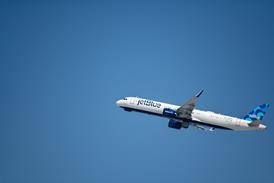Experimental system has potential to boost runway capacity by advising controllers when it is safe to cut distances
A new laser-acoustic and lidar-based detection system in development could give air traffic controllers the ability to increase runway capacity by decreasing wake vortex-driven separation standards.
Developed by NASA, the US Transportation Department and Connecticut-based Flight Safety Technologies, the Aircraft Wake Safety Management (AWSM) system is designed to advise air traffic controllers when it is safe to use minimum traffic separation standards between incoming aircraft, distances that generally range from 2.5 to 3nm (4.6 to 5.6km) in-trail spacing.
Today, controllers can elect to increase spacing to as much as 8nm (and up to 10nm for the A380) between aircraft because of the potential for wake turbulence encounters, a distance proportional to the relative size of the leading and trailing aircraft.
Vortices, most pronounced when a heavy aircraft is flying low and slow, can result in an uncontrolled roll motion when downstream aircraft cross the path of the rotating air flow before it dissipates, descends or drifts downwind.
AWSM uses a combination of sensors, real-time weather data and predictive algorithms to test for the presence or likelihood of wake vortices at critical positions along the flight path to or from the airport. By using real-time weather input, AWSM generates vortex predictions and backs up the estimates with real-time measurements with lidar and the laser-acoustic sensor.
Neal Fine, senior vice-president of technology for Flight Safety Technologies (FST), says the company first developed the listening technique (see box) for the US Navy as part of an underwater acoustic detection system.
Look and listen for safety |
|---|
| The NASA-funded experimental Aircraft Wake Safety Management (AWSM) system tested at the Denver International Airport in 2005 used a lidar package at the runway threshold and a laser-acoustic system about 3nm (5.6km) from the runway end, at the so-called stable approach point, to gather data.
The two technologies are complementary: the lidar system, built by Lockheed Martin, determines turbulence by measuring laser light reflected by moving air particles. The laser-acoustic sensor built by Flight Safety Technologies (FST) is a listening device that captures the sound generated by the vortex via changes in the index of refraction of the air caused by the sound as it passes through the laser beam. |
|
|
|---|
Fine says FST plans to educate safety regulators and air traffic controllers on the principles behind AWSM early this year at Denver International Airport. The "canned" simulation will use the simultaneous laser, lidar and weather data taken during 2005.
Later, the company hopes to perform a "live" emulation of the system using real-time data collected at Denver and a display of the system's output at a remote location, perhaps in the tower cab. Airports showing interest include Anchorage, Honolulu, Las Vegas and Memphis, as well as Dubai and Singapore.
Assuming AWSM could be approved by the US Federal Aviation Administration, Fine says a system that monitors both ends of two or more runways would cost about $15 million to install.
Source: Flight International




















